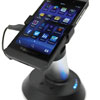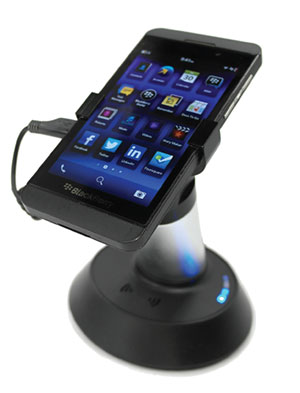
Stopping Theft in Its Tracks
Increasing cost of technology requires line of defense
- By Pete Gulick
- Apr 01, 2014
 The evolution of line security for handheld electronics
in retail stores has been nothing short
of amazing. When Scorpion Security Products
launched its Scorpion security device, telecommunication
and consumer electronics companies
around the globe wanted the most unobtrusive, minimal security
possible. If invisible security could have been provided,
retailers would have jumped at the chance, especially those selling
phones, tablets, computers and cameras.
The evolution of line security for handheld electronics
in retail stores has been nothing short
of amazing. When Scorpion Security Products
launched its Scorpion security device, telecommunication
and consumer electronics companies
around the globe wanted the most unobtrusive, minimal security
possible. If invisible security could have been provided,
retailers would have jumped at the chance, especially those selling
phones, tablets, computers and cameras.
Due to the increasing cost of these products and their amazing
technology, the level of theft around the world has increased
significantly. The loss has been so staggering that many retailers
are now pleading for a highly-secure, bolt-down solution that the
“cut-and-run” thieves will not be able to beat. These bolt-down
versions are nice for interactions but are so secure that thieves are
unable to loosen them.
Scorpion has been ahead of this trend during the last five
years. It is only in the most recent year that more and more of
these retailers are now requesting or specifying the highest level
of security. They realize that having no products on display is
far worse than not having a phone or tablet highly secured.
After all, the day of holding the smartphone to your ear to see
how the phone feels is fading fast. Shoppers still do it out of
habit when able; however, when they cannot, they will know
how to operate an iPhone or Android smartphone just fine.
Never Taken for Granted
It is important that security not be taken for granted so competing
line security companies continue to look for advanced
technology to bring better solutions to the market.
For example, Scorpion has recently partnered with a Netherlands-
based company, SellMore, to create a new, RFID-driven,
bolt-down security solution that is able to be removed at any
time for showing customers or remerchandising departments.
Security companies that stay ahead of their competition
look more at partnering with other technology-based companies
to gain an advantage at securing these valuable products
better than others. As business dictates, those that continuously
evolve with assistance are far more likely to be successful
than those that continue to create within and are
not keeping up with the latest trends.
The Scorpion Difference
The difference with Scorpion
products is that they were created
with the sole purpose of securing
handheld electronics. Most, if
not all, of our competitors were
securing many other products
when the cellular boom took place
in the early 1990s. This created a
unique opportunity for Scorpion
to create specific, product-driven
solutions versus modifying current
products to secure and
properly merchandise cellular devices.
Just like in any business or purchasing decisions, quality
should be the first priority; however, in many cases, the product
purchased is far inferior to the required level of security. There
are many companies that now provide and promote “quick fix”
solutions to security needs, in which the supplier ends up explaining
the poor quality of the product and reason for high
theft versus explaining why their product is better, even at a
little higher price.
There is no gray area when it comes to line security. To make
sure shrinkage is kept to a minimum, it is important to invest in
the line security products that will keep your products secured
while providing a pleasant, end-user experience.
Levels of Security
There are various levels of security required in many retail
locations. High-theft, large-traffic areas like New York City,
Los Angeles or Chicago require the highest level of security
available, like a bolt-down option or a pin and washer solution.
The latter is a ?-inch-diameter, steel rod that cannot be
cut but allows for the customer to pick up the phone or tablet
from the display. There are also several levels of aircraft cable
available that is extremely difficult to cut, providing an acceptable level of security while allowing the
consumer to have full interaction with
the product.
Medium and low-security areas,
such as a mall kiosk that is staffed or
a retail store with many associates, are
less likely to need the highest level of
security. These locations tend to use a
standard mechanical product or even a
hinged sensor, complete with an alarm
system that provides a 100+ decibel
alarm when cut or tampered with by a
potential thief. These provide sufficient
security and can be an excellent option
for lower security areas.
Fool Proof Line Security
There have been solutions presented
where a chip is placed under the battery
or battery cover of a smart phone,
with an RFID reader inside the store.
If the product leaves its comfort zone,
the alarm will sound. Great idea, right?
NO. Little Johnny doesn’t know that the
pretty, shiny phone lying on the counter
is not his if there is nothing holding it
in place. He picks it up and starts walking
around the store; the alarm goes
off every 10 seconds. A shopper’s worst
nightmares come true. And, if thieves
are willing to cut-and-run, this only allows
them a quicker exit.
Line security needs to be fool proof
enough that alarms are not sounding
every five minutes. Most of us have
been in stores where the alarms keep
going off, and store personnel must
stop what they are doing to go over and
turn it off. False alarms turn your associates
into police and your customers
into suspects. This is not what line security
is designed to do.
A combination of mechanical
and electronic security prevents false
alarms, since the phone, tablet or
Phablet is physically secured to the
alarm sensor; yet, many competitors
simply do not provide this type of solution,
causing major issues for retailers.
Of course, everyone considers their
product to be superior to others. Like
the brand of car you drive, there are
features and benefits to every brand, or
in this case, line security supplier, that is
more to the liking of the buyer.
Line security will continue to evolve,
and there is good reason to believe
someone will come up with a gimmick
or technique that they will promote as
the new highest level of security. However,
everyone should always remember
this: You cannot change the law
of physics. Basic security of some type
will always be required to keep honest
people honest.
This article originally appeared in the April 2014 issue of Security Today.